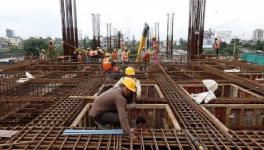International Finance and the Contractionary Macroeconomics of Union Budget 2022-23
The Union Budget 2022 projects that the government's total expenditure will increase to Rs 39,44,909 crore in 2022-23 compared to its level in 2021-22 as per the revised estimates. In nominal terms, this amounts to a 4.6% increase. If the inflation rate exceeds that which prevailed in 2021-22, then this would result in a fall in real terms of the government's total expenditure in 2022-23. The inflation rate could rise due to several factors, such as a rise in indirect taxes (partly planned for in the budget) and international oil prices (if they are passed on to domestic buyers).
However, the Union government claims that the planned rise in government capital expenditure (at a rate that will exceed any conceivable rate of inflation) will crowd in private investment. Is this argument tenable?
If the government's total expenditure is falling in real terms, this will reduce capacity utilisation. Capacity utilisation is the ratio of demand determined output to potential output. Potential output is proportional to the capital stock in economies such as India since there is significant surplus labour. Other things remaining the same, this fall in capacity utilisation will depress private investment (both domestic and foreign). Further, the planned (and eminently foreseeable) increases in indirect taxes on universal intermediates such as petroleum/diesel will reduce the share of wages in output.
This will be the case since most workers who are either informally engaged in the unorganised sector or unemployed will be unable to bargain for and obtain higher wages to compensate for this rise in prices. This fall in the share of wages in output will, in turn, increase excess capacity since, unlike workers, the corporate sector tends to save a significant share of its profits. This rise in excess capacity will impart an additional adverse impact on private investment.
However, all these adverse impacts could be effectively countered if government capital expenditure sufficiently crowds in private investment. It needs to be emphasised that government capital expenditure has a dual impact on private investment with one direct channel operating through capacity utilisation and the other by sufficiently increasing the future profitability of some projects that the private (and especially the corporate) sector currently considers unviable. Since the direct impact will not operate when total government expenditure does not rise, consider the second channel.
The construction projects initiated by government capital expenditure could have long gestation lags that may lengthen due to adverse factors such as a recurrence of another wave of the COVID-19 pandemic or a rise in international oil prices. Therefore, the expected crowding in private investment by government capital expenditure may not transpire. Even if it happens, its magnitude may not be large enough to counteract the adverse impact of a rise in excess capacity due to a fall in total government expenditure (that may be exacerbated by a fall in the share of wages in output). Further, past experience indicates that the actual rise in annual government capital expenditure may be lower than what has been budgeted, which would further amplify the contractionary macroeconomic policy impulse.
Why is the Union government distinguishing between a stagnant/falling government revenue expenditure and an apparent rise in the capital expenditure the highlight of its strategy in the Union Budget 2022? In other words, why can't there be an increase in both the revenue and capital expenditure of the union government? Policymaking in India is in thrall to international finance. In the absence of capital controls, a rise in the fiscal deficit ratio to the gross democratic product beyond an "acceptable level" may trigger a ratings downgrade by credit rating agencies. This downgrade will be followed by capital flight and, therefore, economic setbacks that the neoliberal project in India cannot countenance.
The continuous cultivation of "investor sentiments" is necessary to retain the confidence of international finance. There are many announcements in the Union Budget 2022 regarding "vision", "policy stability", and so forth that are meant to reassure international finance and the corporate sector. Still, these do not involve government expenditure. Since verbal assurances can go only that far, these policy announcements also involve tax reductions for the corporate sector and a greater thrust towards privatisation of the public sector. However, the consequent contractionary macroeconomic policy thrust cannot result in sustainable solutions to the problems of rising unemployment and precarious employment, mounting inequality, and agrarian crisis.
A viable alternative to this policy quagmire has to begin with the institution of capital controls. The institution of capital controls would logically lead to an enhancement of the strategic autonomy of the country. Such a stance of strategic autonomy would enable the diversification of oil supplies towards countries such as Iran and Venezuela. This would allow for the stabilisation of the domestic impact of any rise in international oil prices.
However, this would have to be followed by a wealth tax on the super-rich to finance a sustainable recovery programme from the policy exacerbated COVID-19 crisis. Such a programme would need to involve an increase in revenue and capital expenditure by the government. This increase would need to be centred on policies such as an expansion of rural employment guarantee that is also extended to urban areas, securing the incomes of peasants through a guaranteed minimum support price system of procurement, universalisation of (and enhancement the number of means of consumption provided in) the public distribution system and advancement of public health and public education.
These policies would need to be undergirded by a reinvigoration of the public sector. Only in such circumstances would public investment authentically crowd in private investment.
C Saratchand is a Professor, Department of Economics, Satyawati College, University of Delhi. Views are personal.
Get the latest reports & analysis with people's perspective on Protests, movements & deep analytical videos, discussions of the current affairs in your Telegram app. Subscribe to NewsClick's Telegram channel & get Real-Time updates on stories, as they get published on our website.
























